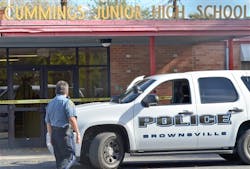Preparing for Attacks the New Norm at Nation’s Schools
The list is substantial; Marjory Stoneman Douglas High School, Sandy Hook Elementary School, Columbine High School and Santa Fe High School.
These are just the most deadly and dramatic. There are many more. These examples of terrorism have heightened our sense of awareness, making us and our children feel vulnerable when entering a school. Students are trained on what to do in the event of a shooter opening fire in classrooms, corridors, and lunchrooms. Rather than being concerned with that day’s test, students of today are worried about staying alive.
There are some think that even think a solution involves arming teachers. Schools, once thought to be safe havens for children, have become sites of unimaginable horror for victims and survivors.
Regardless of your political opinions regarding gun control, the numbers don’t lie. From Jan. 1, 2009 to May 21, 2018, there have been 288 school shootings. Among, the G7 nations, France is second with two school shootings during that time frame. Among all other nations, Mexico is second with eight.
Until the issues of gun control, more funding for schools, and increased on-site police protection are sorted out, we, as a society must acknowledge that this may be the norm for now.
But there are steps schools and school boards should take to minimize damage, reduce injuries, and eliminate the loss of lives. In short, plans can be developed to identify threats and to buy time for first responders to arrive on the scene.
The first element of such a plan is forming a team of professionals from law enforcement, security technologies, engineers, architects, builders and security window film and glazing experts.
They will coordinate a “layered” approach to securing a school - from the outside in, addressing issues of standoff distance, access control, window and door vulnerability and, ultimately, “safe room” provisions for sheltering in place.
While each school requires a custom plan, here are the components of a basic security plan providing added security for everyone who enters:
- Define the threat:
o Based on the layout and location of the school, the frequency of occupancy and crowd density, try to determine those areas most at risk, and what is the most likely threat posed to them. These could be hallways, lunchrooms, gymnasiums.
o Remember, while an armed intruder may threaten forced entry, it is far easier to anonymously deposit a hand-carried explosive device nearby, weaponizing window glass and threatening everyone nearby with the hazard of exploding glass shards.
- Analyze the obvious weak points … doorways … as well as the ground floor windows … particularly those that may be out of a clear line of sight from public roads and sidewalks. Other points to consider:
- Real-time cameras covering the perimeter of a school will provide immediate, vital information.
- Hardening entry doors and ground level window and door glass are effective in slowing forced entry.
- Hardening upper-level windows can secure building occupants against glass-shrapnel injury in the event of a blast from a small nearby bomb.
- Administrative, security and custodial staff and your local police must have up-to-date floor plans with clearly, logically identified locations of all entries, stairs, elevators, rooms and lavatories. Those locations should be labeled with photo-luminescent signage, so they are easily identified, even in the dark.
- Remove hedges, bushes, garbage cans and other obstacles which provide cover for an intruder or an explosive device.
- Fortify entry vestibule with lock-down capabilities in the event an intruder breaches the perimeter entry.
- Consider adding safe exits from areas where large crowding is likely to occur, such as lunchrooms, corridors, and other public assembly areas.
With this information, a security and evacuation plan with the following components takes shape:
- Security personnel at entry points to the school;
- Security cameras to monitor all areas outside and within;
- Limit access points;
- Security/blast-mitigation window film;
- Metal detectors;
- A program to continually receive intelligence from law enforcement regarding trending threats;
- A budget addressing these steps to secure and protect occupants and visitors;
- Education making teachers, tenants and others aware of what to look out for.
No one likes to think of the surrounding threats, but we don’t have a choice. We must acknowledge that it’s a dangerous world, and based on recent events schools seem to be likely targets. We can make a contribution toward our children’s safety with a thoughtful and comprehensive strategy focused on securing schools.
By implementing these measures we may be able to save lives and give everyone the confidence that school systems are doing their part to safeguard students, teachers, staff, and administrators.
About the author: Carol Borow is President of CHB Industries. Based in Hauppauge, NY, the company provides schools, office /government buildings, houses of worships, and homes with creative security, solar, decorative, and anti-graffiti window film solutions. For more information, visit www.chbwindowfilm.com.
